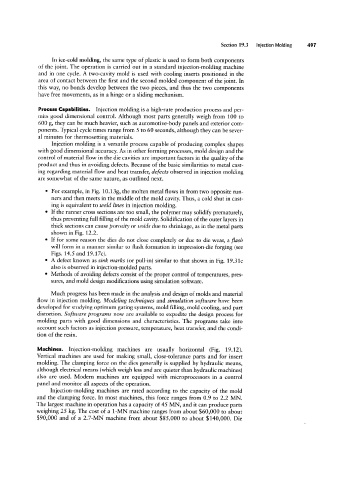Page 517 - 04. Subyek Engineering Materials - Manufacturing, Engineering and Technology SI 6th Edition - Serope Kalpakjian, Stephen Schmid (2009)
P. 517
Section 19 3 Injection Moldlng 7
In ice-cold molding, the same type of plastic is used to form both components
of the joint. The operation is carried out in a standard injection-molding machine
and in one cycle. A tvvo-cavity mold is used with cooling inserts positioned in the
area of contact between the first and the second molded component of the joint. In
this way, no bonds develop between the two pieces, and thus the two components
have free movements, as in a hinge or a sliding mechanism.
Process Capabilities. Injection molding is a high-rate production process and per-
mits good dimensional control. Although most parts generally weigh from 100 to
600 g, they can be much heavier, such as automotive-body panels and exterior com-
ponents. Typical cycle times range from 5 to 60 seconds, although they can be sever-
al minutes for thermosetting materials.
Injection molding is a versatile process capable of producing complex shapes
with good dimensional accuracy. As in other forming processes, mold design and the
control of material flow in the die cavities are important factors in the quality of the
product and thus in avoiding defects. Because of the basic similarities to metal cast-
ing regarding material flow and heat transfer, defects observed in injection molding
are somewhat of the same nature, as outlined next.
° For example, in Fig. 10.13g, the molten metal flows in from two opposite run-
ners and then meets in the middle of the mold cavity. Thus, a cold shut in cast-
ing is equivalent to weld lines in injection molding.
° If the runner cross sections are too small, the polymer may solidify prematurely,
thus preventing full filling of the mold cavity. Solidification of the outer layers in
thick sections can cause porosity or 1/oids due to shrinkage, as in the metal parts
shown in Fig. 12.2.
° If for some reason the dies do not close completely or due to die wear, a flash
will form in a manner similar to flash formation in impression-die forging (see
Figs. 14.5 and 19.17c).
° A defect known as sink marks (or pull-in) similar to that shown in Fig. 19.31c
also is observed in injection-molded parts.
° Methods of avoiding defects consist of the proper control of temperatures, pres-
sures, and mold design modifications using simulation software.
Much progress has been made in the analysis and design of molds and material
flow in injection molding. Modeling techniques and simulation software have been
developed for studying optimum gating systems, mold filling, mold cooling, and part
distortion. Software programs now are available to expedite the design process for
molding parts with good dimensions and characteristics. The programs take into
account such factors as injection pressure, temperature, heat transfer, and the condi-
tion of the resin.
Machines. Injection-molding machines are usually horizontal (Fig. 19.12).
Vertical machines are used for making small, close-tolerance parts and for insert
molding. The clamping force on the dies generally is supplied by hydraulic means,
although electrical means (which weigh less and are quieter than hydraulic machines)
also are used. Modern machines are equipped with microprocessors in a control
panel and monitor all aspects of the operation.
Injection-molding machines are rated according to the capacity of the mold
and the clamping force. In most machines, this force ranges from 0.9 to 2.2 MN.
The largest machine in operation has a capacity of 45 MN, and it can produce parts
weighing 25 kg. The cost of a 1-MN machine ranges from about $60,000 to about
$90,000 and of a 2.7-MN machine from about $85,000 to about $140,000. Die

